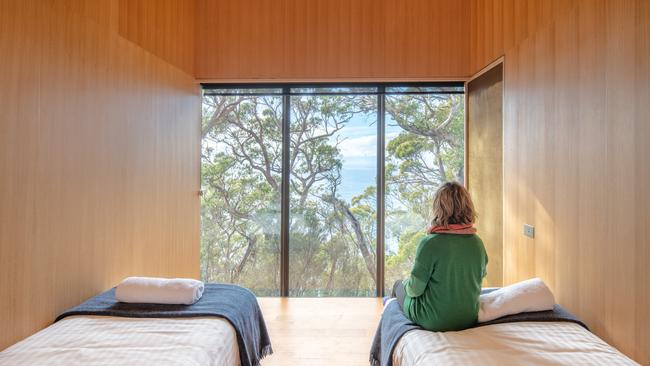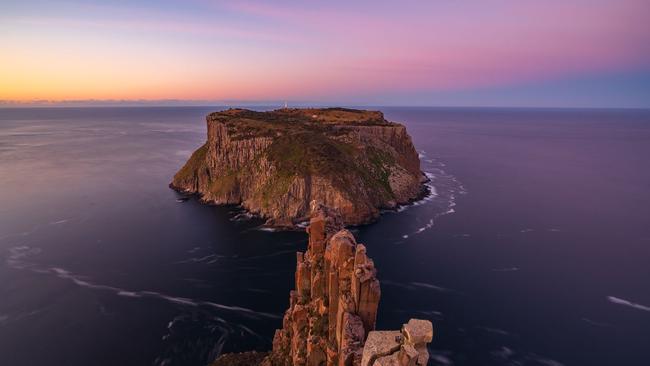Three Capes Lodge Walk, Tasmania
On Tasmania’s Three Capes Track, art and architecture are integrated with their setting in an intimate pairing that amplifies its drama.

An hour or so along the track toward the Tasman Peninsula’s towering sea cliffs – reputed to be the highest, at 300m, in the Southern Hemisphere – the ruins of Port Arthur come into view. Art critic Robert Hughes described this remote prison tailor-made for repeat offenders as “Hell on Earth”. But the colonial administration never lost its taste for refined architecture, even while it punished and exploited thousands of convicts by putting them to work in south-east Tasmania’s old-growth forests. This once-feared penitentiary, visible across the water, is unexpectedly grand and incongruously elegant. There’s a crenelated Martello tower with a temple front in sandstone, and the convict quarters rise four storeys.

A few hours along the Three Capes Track, I drop my rucksack outside a no less remarkable piece of architecture sited in splendid isolation, the first of two award-winning eco lodges in Tasman National Park designed by Sydney architect Andrew Burns for the Tasmanian Walking Company. We arrive in late afternoon at Crescent Lodge, so named because of its commanding views across the ocean to the sandy swath of Crescent Bay and the dolerite columns of Cape Raoul beyond. Port Arthur and all it represents is well and truly behind us; the only vaguely punishing thing about the day has been a climb as the track peels away from the coast.

Crescent Lodge is luxurious for sure, but not in the usual ways. To experience the drama of the natural world in such intimacy is a rare privilege, but so too is the stylish comfort of a minimalist wooden interior with high-end furnishings. Call it, perhaps, virtuous luxury.
The simple stick-like structure, lightweight and modestly clad in a rhythmical play of blackbutt batons, sits on a gently sloping knuckle of rock perched above the ocean. Seven double guestrooms, named after wrecks on this storm-tossed stretch of coast, are arrayed behind a large open-plan lounge-dining room with floor-to-ceiling glazed windows set into a steel frame. Today’s weather belongs to another season, and a wood-pellet heater blazes beside a plank of sofa. From here the borders between interior and exterior dissolve and there’s a powerful sense of not merely observing, but inhabiting, a wild place. On warm days the windows pivot open and the lodge becomes a sheltered plinth resting above the deep folds of the eucalypt forest and the restive sea below.

There’s time for tea with freshly baked lemon cake, a rest and a hot, misty eco-shower – among many sustainability considerations was the need to achieve “maximum saturation for minimum water usage”, says our guide, Eli – before canapés at sunset. We assemble, drinks in hand, at a semi-circular timber viewing platform perched high enough and close enough to make out the textures of currents and wind caressing the ocean’s surface, like unseen hands. A ruby-red sunset sweeps the headlands and colours our dinner with a glass – or two – of decent Tasmanian pinot.
Overnight, a storm hammers us from the south-west and the deck outside is as slick as a ship’s after a hard night at sea. The morning sun is bright, and the eucalypt-scented air medicinally pure. In this gilt light the gum leaves are more lime than grey-green, and many have turned red; these colours lend the landscape a vibrancy and richness I’d not expected. I’ve woken on my birthday, and before a cooked breakfast the lodge chef presents a cake with a candle.

The track winds out of the headlands across a broad, heath-clad valley before climbing Mount Arthur for more stirring views south. To the side of the path there’s a clutch of outsized bronze wedge-tailed eagle eggs in a nest carved from a dolerite boulder by Tasmanian artist Alex Miles, one of five of his artworks along the 48km track.
Our destination for the next two nights is Cape Pillar Lodge. It’s a five-hour trek, through a kaleidoscope of environments, from open coastal heath to dry woodland, and a surprise pocket of cool-temperate cloud forest distinguished by snow gums, mossy logs, and stands of dogwood and sculptural pineapple candle heath.

At regular intervals we pass artfully designed “story seats”, each placed for a contemplative break. There are 27 of them, positioned on headlands and in forest clearings, or niches beside the track. Design and nature are enmeshed on the Three Capes Track. The track itself is a work of art: a sinuous path, much of it raised boardwalk or stone steps as finely crafted as tessellated floors, snaking through landscapes that change in complexion and mood. It’s hard to imagine a walk through pristine national park anywhere in the world with such a design-forward personality.
We arrive at Cape Pillar Lodge off an unmarked track that rises steeply and culminates in 17 – I counted – switchbacks and a slab of still-warm upside-down cinnamon pear cake on arrival.

One of the secrets of Andrew Burns’s architecture on this trail is its propriety and modesty. His two private lodges (sited apart from the three well-designed public alternatives) apostrophise the end of long and eventful days, but they don’t declare their presence. Instead, they draw walkers into a series of inviting, sparsely furnished spaces, offering good food, wine and conversation, and connecting powerfully with the natural world.
Cape Pillar Lodge is a cluster of glass pavilions joined by boardwalks, designed in the same style as its sister lodge but with greater ambition. There’s a discreet spa cabin and plunge pool for post-walk therapy, and a glass-fronted structure at the cliff-face for yoga and contemplation, and from here the view north along the Munro Bight towards Cape Hauy, the third cape, is breathtaking. A Tasmanian oak coffee table and flute-shaped o-bench are by Hobart-based designer Scott van Tuil.

Next day the group presses on to Cape Pillar and a pinnacle aptly named the Blade, returning with tales of sea cliffs and seals, bonsai banksias and views of the crushed hat of Tasman Island. I decide to linger at the lodge to enjoy the inside-outside experience in solitude. The weather changes every few hours. One minute the lodge is bathed in the peculiarly intense southern summer sunshine, the next it’s thrashed by rain and a whistling wind, and the temperature has dropped to single figures. Today’s afternoon tea involves a plum tart; last night there was chocolate three ways after baked Tasmanian ocean trout, and tonight there’ll be Christmas pudding after lamb tagine.

Every calorie is put to use on the final day, a 20km walk north to the icing-sugar white beach of Fortescue Bay, and we start early for our hike up and over Mount Fortescue, the highest point of the track. The path wends through dark fern forest, past more curious benches –including the startling Blood on the Velvet Lounge, a couch of welded steel, powder-coated blue with a splash of red evoking an encounter with a forest predator. This is the work of Launceston designer Luke Dineen, who designed a pair of squat bug-like wooden seats nearby, as well as several seats with fellow designer Simon Ancher (see WISH August 2019).
As we climb towards the summit, 490m above sea level, our guides suggest we set off through the dripping, mossy forest a minute apart. This silent, somewhat monkish practice, known in Japan as shinrin-yoku or forest bathing, is said to be therapy for ailments from cancer to high blood pressure. I’m suddenly aware of my breath, and then my thumping heart, as I move through this dark, green world with its cool liquid air.

It’s mid-afternoon when we come off the coastal uplands and down mosaic-stone steps, a little weary and footsore. On the way there’s one last work by Alex Miles: a set of four oversized abalone shells of cast concrete among boulders and timber posts etched with patterns of sea kelp and she-oak. I descend to the bright, white cuticle of Fortescue Bay, rip off boots and sweaty socks, and plunge my feet into the chill water – as reviving as the morning’s forest bathing.
Back at the company’s HQ in inner-city Hobart, I hop on the scales. Even after 50km of exertion, I’m exactly the same weight as I was on the morning we set out. Clearly, it’s the effect of the Three Cakes Track.
Guests on the Tasmanian Walking Company’s three-night Three Capes Lodge Walk stay in two eco lodges in Tasman National Park. The company also runs guided walks in the Bay of Fires, and in Freycinet and Cradle Mountain-Lake St Claire national parks. taswalkingco.com.au
